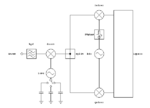neazoi
Advanced Member level 6
I was thinking of a way to remove the need for a crystal filter (filter method), or a multi-band phaser circuit (phasing method), in a multi-band SSB HF transceiver, without the use of a quadrature DDS or frequency division of a higher frequency oscillator for phasing.
I came up with this diagram. It is a single frequency (IF) quadrature transceiver block, combined with a superhet RF front end.
The quadrature block will work in the IF only, to reject the opposite sideband, whereas the superhet image will be removed by the front end BPF. And since the quadrature block works only on one frequency, there is no need to readjust the phasing when the frequency of the transceiver is changed.
The front end oscillator is a wide range VFO, capable of covering the IF/LO difference.
I do not see the reason why it wouldn't, but will this actually work?
I came up with this diagram. It is a single frequency (IF) quadrature transceiver block, combined with a superhet RF front end.
The quadrature block will work in the IF only, to reject the opposite sideband, whereas the superhet image will be removed by the front end BPF. And since the quadrature block works only on one frequency, there is no need to readjust the phasing when the frequency of the transceiver is changed.
The front end oscillator is a wide range VFO, capable of covering the IF/LO difference.
I do not see the reason why it wouldn't, but will this actually work?
